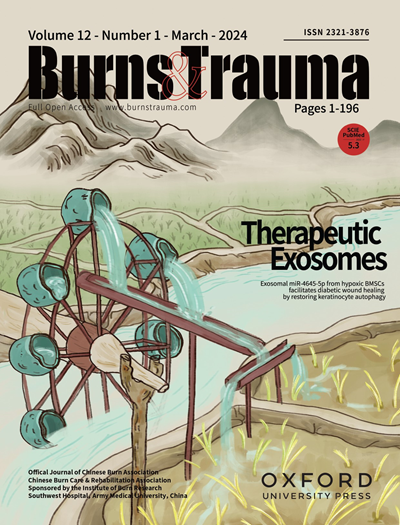快速犀牛在外伤性心脏骤停引起的穿透性颈部损伤出血控制中的应用
IF 6.3
1区 医学
Q1 DERMATOLOGY
引用次数: 0
摘要
穿透性颈部损伤是一种严重的、危及生命的事件,如果患者想在没有显著发病率和死亡率的情况下生存,就需要进行先进的快速治疗。大容量中心的院内范例包括使用Foley导管球囊填塞来暂时或彻底控制颈动脉鞘结构出血,尽管这些技术在现场不太常用。我们强调的情况下,一个25岁的男性谁提出了救护车服务与三个自己造成的颈部伤口-一个到颈部的每个区域。2区伤口横断颈内静脉和同侧椎动脉,造成严重出血,导致低血容量性心脏骤停。患者采用改良的填塞技术进行治疗,使用Rapid Rhino 900™鼻出血导管,在充气前将缝线固定在2区伤口。这导致完全止血,使患者能够进行复苏,麻醉并由空中救护车运送到区域创伤中心。他的伤得到了治疗,他的康复只是被短暂的霍纳综合症打断了。本报告展示了首次对一项著名的医院内技术进行修改,事实证明,这种技术在本病例中挽救了生命,并可用于其他病例。我们讨论导管填塞技术相对于直接包装的重要性,特别是对于那些需要在医院内、医院间或医院间运输的患者。这与其他主张直接包装为主要治疗方法的作者形成鲜明对比。本文章由计算机程序翻译,如有差异,请以英文原文为准。
Use of a Rapid Rhino in haemorrhage control for penetrating neck injury presenting in traumatic cardiac arrest
Penetrating neck injuries present as serious, life-threatening events which require advanced expeditious management if the patient is to survive without significant morbidity and mortality. In-hospital paradigms for high-volume centres include the use of Foley catheter balloon tamponade to temporarily or definitively control haemorrhage from carotid sheath structures, although these techniques are less commonly deployed in the field. We highlight the case of a 25-year-old male who presented to the ambulance service with three self-inflicted neck wounds – one to each of the zones of the neck. The zone 2 wound had transected the internal jugular vein and also the ipsilateral vertebral artery, causing severe haemorrhage leading to hypovolaemic cardiac arrest in a remote farmhouse location. He was treated with a modified tamponade technique, employing the use of a Rapid Rhino 900™ epistaxis catheter, secured with sutures into the zone 2 wound prior to inflation. This resulted in complete haemostasis, which allowed the patient to be volume resuscitated, anaesthetised and flown by air ambulance to the regional trauma centre. His injuries were treated and his recovery was interrupted only by a transient Horner's syndrome. This report showcases the first time this modification of a well-known in-hospital technique was deployed, which proved life-saving in this case and could be of use to others. We discuss the importance of catheter tamponade techniques as opposed to direct packing, in particular for those who need to be transported either within, between or to the hospital. This is in contradistinction to other authors advocating direct packing as the mainstay of treatment.
求助全文
通过发布文献求助,成功后即可免费获取论文全文。
去求助
来源期刊

Burns & Trauma
医学-皮肤病学
CiteScore
8.40
自引率
9.40%
发文量
186
审稿时长
6 weeks
期刊介绍:
The first open access journal in the field of burns and trauma injury in the Asia-Pacific region, Burns & Trauma publishes the latest developments in basic, clinical and translational research in the field. With a special focus on prevention, clinical treatment and basic research, the journal welcomes submissions in various aspects of biomaterials, tissue engineering, stem cells, critical care, immunobiology, skin transplantation, and the prevention and regeneration of burns and trauma injuries. With an expert Editorial Board and a team of dedicated scientific editors, the journal enjoys a large readership and is supported by Southwest Hospital, which covers authors'' article processing charges.
 求助内容:
求助内容: 应助结果提醒方式:
应助结果提醒方式:


